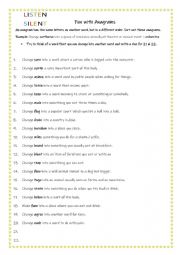
|
Anagrams
This worksheet is suitable for A2 students.The idea being for students to read each sentence and understand the description and recognise the spelling of that word.
Level: elementary
Age: 8-14
Type:
Downloads: 449
|
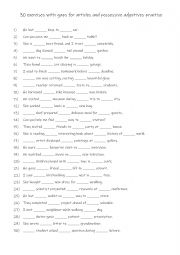
|
Articles and possessive adjectives practise
Students read the sentences and work out what article ( a, an , the) is needed and what possessive adjective is needed according to the subject. Answers on page 2
Level: elementary
Age: 8-100
Type:
Downloads: 107
|

|
As a result and therefore (1)
This gap-fill exercise is suitable for students at an intermediate level, specifically around B1-B2 on the CEFR (Common European Framework of Reference for Languages) scale. At this level, students are expected to have a good grasp of basic grammar and vocabulary, and exercises like these help reinforce their understanding of how to use conjunction...
Level: intermediate
Age: 12-100
Type:
Downloads: 106
|
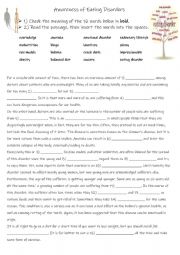
|
Awareness of Eating Disorders
Reading passage with a gap fill exercise about being aware and recognising signs of eating disorders. This sheet is suitable for higher level B1 to B2 students of all ages. An answer sheet is included. For higher level students they could be put in groups to give / present their opinions in a presentation / discussion.
Level: intermediate
Age: 14-100
Type:
Downloads: 1956
|
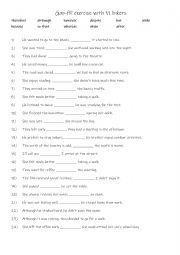
|
B1 11 Linkers practise with 24 sentences
Linkers help clarify the relationships between ideas in both spoken and written communication. For instance, "however" shows a contrast between two ideas, while "because" indicates a reason.In formal writing, especially academic and professional contexts, the proper use of linkers is crucial for articulating complex ideas clearly and persuasively. ...
Level: intermediate
Age: 10-100
Type:
Downloads: 113
|
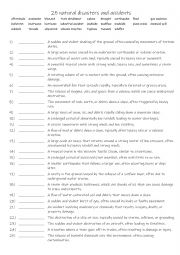
|
B1 25 natural disasters and accidents
Learning vocabulary related to natural disasters and accidents is crucial for understanding the impact of such events on communities, economies, and the environment. These terms enable students to communicate effectively in emergencies, describe events accurately, and engage in global conversations about disaster management and climate resilience. ...
Level: intermediate
Age: 10-100
Type:
Downloads: 124
|
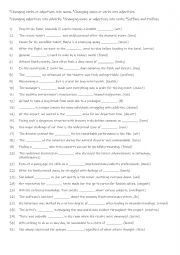
|
B1 -B2 5 Different types of word formation.
This worksheet contains the following:*Changing verbs or adjectives into nouns. *Changing nouns or verbs into adjectives.
*Changing adjectives into adverbs. *Changing nouns or adjectives into verbs *Suffixes and Prefixes. Answers on page 2.
Level: intermediate
Age: 10-100
Type:
Downloads: 104
|
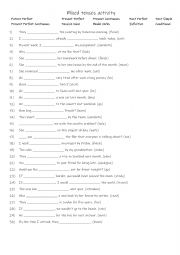
|
B1 -B2 10 Mixed tenses
Students familiarise themselves with the 10 tenses and their uses. Then they read the sentences to see which tense is needed to complete then gap-fill with the given verb. Each tense is used 3 times. Answers on page 2.
Level: intermediate
Age: 8-100
Type:
Downloads: 121
|
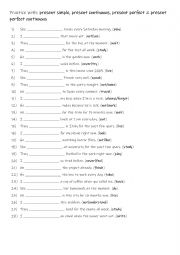
|
B1 -B2 Practice with present simple, present continuous, present perfect & present perfect continuous
Learning the present simple, present continuous, present perfect, and present perfect continuous tenses is crucial for students as these tenses allow them to express a wide range of meanings related to actions and states in the present. The present simple is used for routines and facts, the present continuous for actions happening now, the present ...
Level: intermediate
Age: 9-100
Type:
Downloads: 108
|

|
B1 -B2 Practice with present simple, present continuous, present perfect & present perfect continuous
Learning the present simple, present continuous, present perfect, and present perfect continuous tenses is crucial for students as these tenses allow them to express a wide range of meanings related to actions and states in the present. The present simple is used for routines and facts, the present continuous for actions happening now, the present ...
Level: intermediate
Age: 9-100
Type:
Downloads: 134
|












